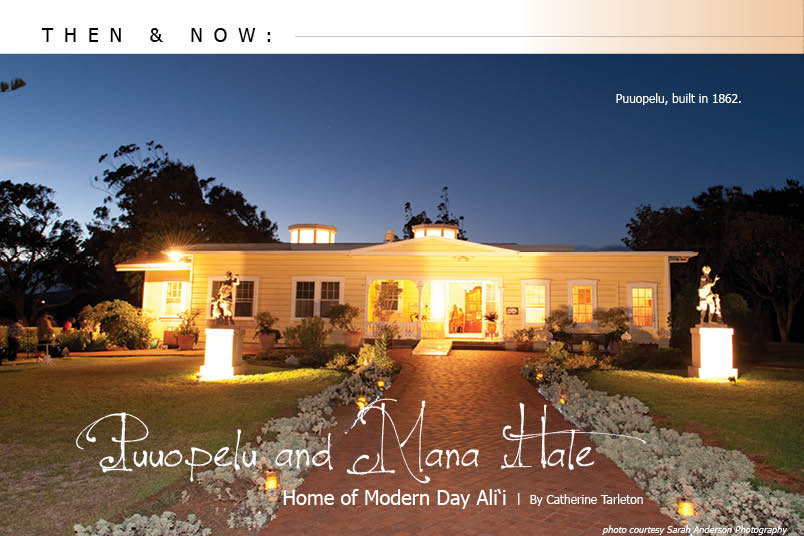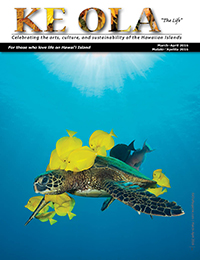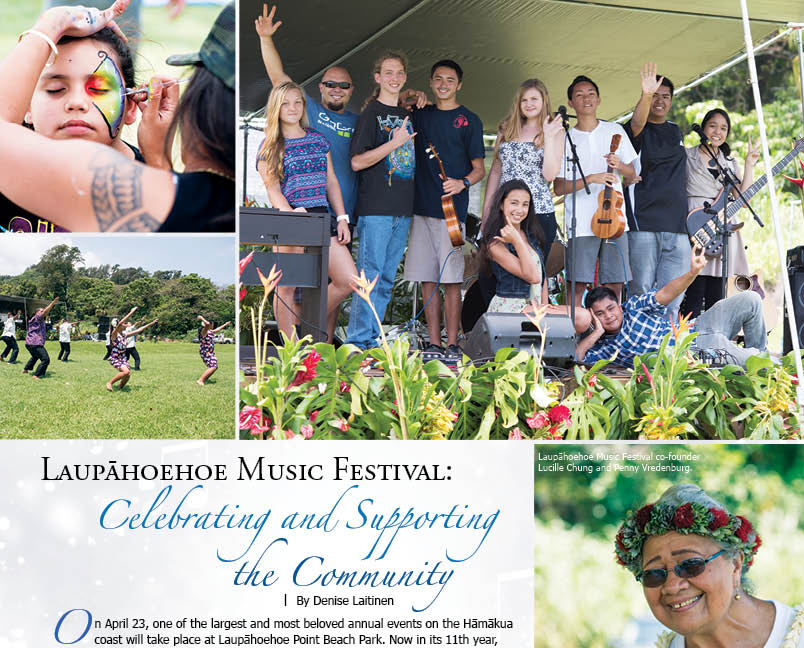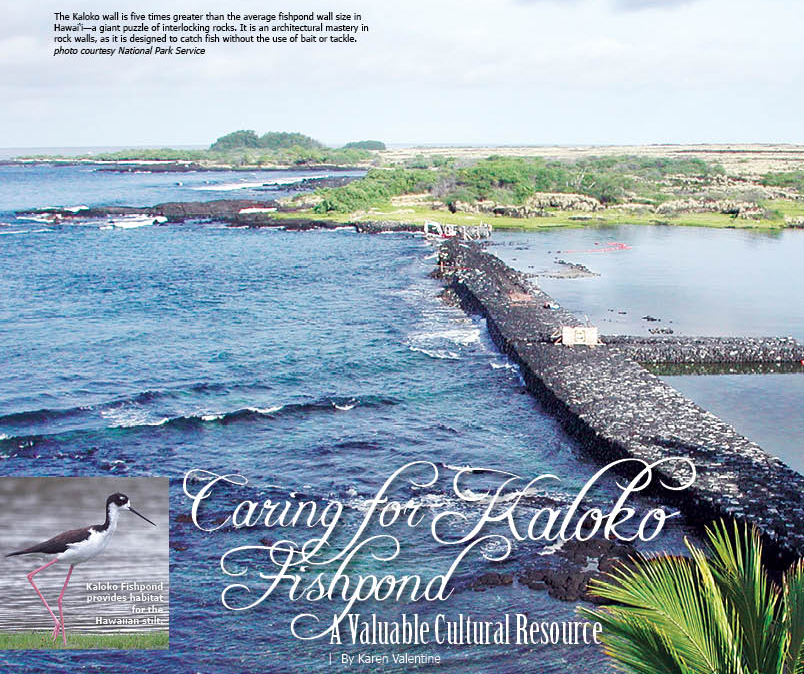
Puuopelu and Mana Hale: Home of Modern Day Ali‘i

By Catherine Tarleton
Two long rows of eucalyptus bow to the left, in respect to the prevailing makani (wind) from Kohala Mountain. Through the gate, down the long lane leading to Parker Ranch’s historic homes, there are horses grazing in knee-deep green. A monumental Norfolk pine stands welcome at the circular drive. The mental radio plays the opening theme of Gone With the Wind.
This is Puuopelu, the 154-year-old “Hawaiian Victorian” mansion home of the legendary Parker family for six generations. On its right shoulder, “Mana Hale,” (house of spirit), an unassuming white New England style house that conceals a magnificent solid koa interior, moved board-by-board and reassembled there from its original location, 12 miles away.
The rooms and gardens of these two houses tell an epic story—filled with drama, romance, hard work, conflicts of history, and colors of the finer things: art, music, and theater. Preserved, yet not kept under glass, the historic homes continue the story today, as headquarters of the venerable Parker Ranch in Waimea.
Act I
The story of Parker Ranch and its historic homes actually begins with five cows, given to King Kamehameha I from British Captain George Vancouver in 1788. Released into the countryside and placed under kapu (taboo) for 10 years, the cattle multiplied rapidly, taking over the landscape, threatening agriculture and damaging property.

In 1809, a young sailor, John Palmer Parker, 19, arrived from Massachusetts and left his ship to explore. He ended up staying on the island, and soon after he was introduced to the King, who recognized him as an asset and put him to work. Eventually, John was given permission to shoot the wild cattle with his muzzleloader and to trade beef and hides with harboring ships.
John learned to speak Hawaiian quickly, worked hard, and soon became a wealthy and respected man. In 1816, he married Chiefess Kipikane, ali‘i granddaughter of Kamehameha, and purchased two acres of pastureland for about $10. They lived in a Hawaiian-style thatched roof hale while building Mana Hale, a small home reminiscent of Parker’s New England upbringing on the outside and of a sturdy ship indoors. Here, John and Kipikane raised three children and began a dynasty that would last 200 years.
Mana Hale was and is a two-story Cape Cod “salt box” house, with a steep slate roof and plain white walls, small windows, and a dormer. Its three bedrooms, sitting rooms, and great room are completely koa—floors, walls, ceilings, and much of the furniture. The result is beyond warm—a glowing home, filled with sunshine and spirit.
In the 1850s, Kipikane was granted 640 acres; John bought another 1,000 acres the next year and also leased land in the Waikoloa region. About the same time, Kamehameha III invited the first paniolo to Hawai‘i—the Spanish-Mexican vaquero (cowboys) from California, who trained Hawaiian workers to rope and handle cattle. Parker Ranch grew quickly.
Mana Hale hosted travelers frequently, and John would sing, chant, and tell Hawaiian stories, as taught by his brother-in-law, Kapua‘a. The property had separate cooking and bath houses, and at one time included similar two-story homes for John’s sons, John II and Ebenezer, and their families.
John I died in 1868, leaving his son, John II, and grandson, Samuel “Kamuela” Parker, as heirs after the tragic death of Ebenezer. Samuel went to school with David Kalākaua, who would become Hawai‘i’s first elected King. The “Merrie Monarch” appointed Samuel to his Privy Council, and Queen Lili‘uokalani had him as her Minister of Finance and Minister of Foreign Affairs at the time she was deposed. His daughters often invited their friend, Princess Ka‘iulani, to the ranch before her untimely death. Historic photographs remain on the koa walls, giving us a glimpse of the monarchy relaxing at Mana Hale.
In 1879, John II and his wife, Hanai, purchased Puuopelu, originally built in 1862 by Englishman Charles Notley, for $2,720, which included seven acres of land. Puuopelu then became the heart of Parker Ranch operations. The couple adopted Samuel’s son, John III, as their heir, however, he too died suddenly at only 19, leaving wife Elizabeth and infant daughter Thelma. “Elizabeth wisely recruited well-respected businessman Alfred Wellington “A.W.” Carter to manage the ranch and protect Thelma’s interests. A.W. had been both practicing attorney and judge, with a Yale law degree.”
Years passed; Thelma married Gaillard Smart and gave birth to Richard in 1913. He was orphaned at age two when Thelma died of tuberculosis and Gaillard of meningitis. Elizabeth, who became known as “Auntie Tootsie,” again took the Parker Ranch heir under her wing. They lived in San Francisco for the most part, visiting Puuopelu every summer, and Richard developed a great love for the theater. He attended Stanford University and then signed on with the Pasadena Playhouse.
Act II
On his 20th birthday, Richard became the sole owner of Parker Ranch. Knowing he was more of an entertainer than a cattle baron, Richard trusted the ranch to the capable hands of A.W. Carter while he followed an acting career that led to success on Broadway. Under A.W.’s, and later son Hartwell’s leadership, the ranch grew to over 500,000 acres, about half of Hawai‘i Island. Parker Ranch was central to Waimea’s culture and the hardworking paniolo families who built lives there.
It was Richard who made Puuopelu the grand estate at the heart of Parker Ranch. When he returned to stay in 1960, he divided the kitchen wing (added in 1910) to create a formal dining room. He replaced the wooden living room with a concrete and steel structure and raised the ceiling to 16’, adding octagonal skylights and crystal chandeliers. The result is an elegant, soaring 55’ by 35’ drawing room, complete with baby grand piano, French Victorian furniture, Italian marble fireplace, and classic French doors leading to a wide lānai that overlooks a terraced garden, and Waimea’s green hills.
On the home’s front lawn with bricked walkway, he placed two statues of Greek deities: Apollo, god of music, song, poetry, and the protection of the young, and Diana, goddess of the moon, wild animals, and the hunt. Behind the house, he planted rose gardens, his mother’s favorite gardenias, and French lavender.
The expanded Puuopelu could properly exhibit Richard’s prized art collection. At the time, 75 original paintings graced the walls—by such notable European painters as Wilfrid Gabriel De Glehn, Constantin Kluge, Pierre Eugene Montezin and Edgar Degas. Many are cityscapes of Venice, a place he loved and returned to yearly. Collections of Murano art glass, Chinese pottery, and Japanese bronzes fill custom niches, alongside an antique armoire containing John I’s muzzleloader and the sword given to Samuel, as a Knight Commander of the Royal Order of Kamehameha.
Family portraits peer down onto visitors as they peruse Richard’s Broadway memorabilia showcases, chronicling his 30 years in entertainment with playbills, record album covers, news clippings, props, and photos of him with theater colleagues such as Nanette Fabray, Eve Arden, Carol Channing, and others. It’s easy to imagine Richard’s Puuopelu as the setting for elaborate parties, costume balls, trail rides, and receptions for traveling dignitaries from the Hawaiian Islands and around the world.
In 1986, five years after building the Kahilu Theatre (see p63) Richard decided to move his ancestral home, Mana Hale, to the estate. His intention was to relocate the little house in its entirety, but the slate roof was too unstable, so he had it and the exterior walls removed. The interior walls, floors and ceilings were dismantled, numbered, and restored piece-by-piece into a replica of the original home he had constructed next door to Puuopelu.
At Mana Hale today, a picture of stone-faced John I greets visitors to the home, with its remarkable collection of eclectic items that speak to the intricate relationship between the ranch culture and Hawaiian culture. One cabinet holds a row of hand-carved tiki sculptures, below, in a glass case, stone poi pounders and implements. In a nook, a koa treasure chest; on a table, china teacups and saucers. Hawaiian tree saddles in the great room, farm implements, and photos on a side porch. Lauhala mats on the floor beneath a modern sofa and chairs. In the bedroom, a million-stitch Hawaiian quilt on a masterpiece of a koa bed; beside it a replica of Samuel’s wife Panana’s red dress; an oil portrait of her hangs on the wall.
Upstairs, the koa bedrooms and sitting room pay tribute to Auntie Tootsie and Thelma, with photos, jewelry and catch-all boxes on the dressers. Dresses, hats, and framed family photos on display. In “Thelma’s” room, a copy of her sky-blue empire waist dress stands in one corner, her portrait wearing it in the other. A guitar and ‘ukulele on the cushioned recamier sofa are the remains of the musical talent she shared with her son, even though she barely knew him.
Richard Smart passed away in 1992, after creating the Parker Ranch Foundation Trust to help serve the education and health needs of the community, with four beneficiaries: North Hawai‘i Community Hospital, Parker School Trust Corporation, Hawai‘i Preparatory Academy, and Hawai‘i Community Foundation.
Act III
In 2008, after years of change and challenge, Parker Ranch closed the museum and visitor center that were located in Parker Ranch Shopping Center. In 2011, they moved operations to the Puuopelu property. Its bedrooms are offices, the dining room a conference room, and the historic homes remain open to the public during business hours.
“I think Richard Smart and the Parker family would be happy there is life here,” says Mel Sanchez, Executive Assistant, whose office was the Broadway Room. Her boss, Parker Ranch CEO Dutch Kuyper works out of Richard’s former bedroom, where an oil painting of A.W. Carter supervises him.
“When I started in March of 2011 the board had made the decision to move offices,” says Dutch. “I love it. People have no idea—people from the mainland—that this history is still alive.” Originally from O‘ahu, Dutch spent most of his work life on the east coast before coming to the ranch.
“It’s interesting where we are right now. In a way, it’s like going back in time. That element of going through changes during the credit crisis made us refocus on things that really matter. And, family and community are on the short list of things that matter…Waimea is an incredible community. We have a lot of families whose histories are directly tied to Parker Ranch.”
“We wouldn’t have ranching in Hawai‘i if we didn’t have people who chose that lifestyle for themselves and their family,” says Dutch. “I never had a job that had such a community dimension to it.” Puuopelu, is still the heart of Parker Ranch, as they carry on the Parker traditions, including two annual rodeos and the Christmas tree lighting.
“I call it a ‘Dr. Seuss’ moment,” says Dutch. “Everybody’s invited to the house. Inside, we have entertainment, a hula hālau, Hawai‘i Preparatory Academy handbell choir, Hawaiian Civic Club Choir…and then we all pile outside at dusk to sing carols around the big Norfolk Pine. We pull one child out from the crowd, we count down from 10 to one, and the kid pulls the switch. It’s awesome. Who gets this kind of job?”
While the ranch has diversified their operations, Dutch says they will always be a cattle ranch, although that’s only one “leg” of their current three-legged strategy [with renewable energy and community development]. “Local beef will be more sustainable for us,” says Dutch. “It’s better for the land as land stewards, better for the environment as far as the carbon footprint.”
“Richard in his own way, I think, knew what sustainability was,” says Dutch. “He must have believed that education and healthcare were pillars of a sustainable community. That’s why he left the ranch to a trust, benefiting the schools and hospitals.”
“Parker Ranch’s future is directly tied to the future of Waimea,” Dutch continues. “And I think the Big Island is the future of Hawai‘i…We have this diamond we need to protect, promote, and polish.”
“In the long run, the potential for cultivating value here is awesome. I’m just the gardener—tilling rows, planting seeds, pruning, cultivating value.”
Before returning down the eucalyptus-lined drive, a visitor might walk around Puuopelu, take in its cultivated gardens, and reflect on the values it represents in Hawai‘i Island’s living culture. Behind the house, in the peaceful family columbarium, terra cotta colored statues stand watch over Richard’s rose gardens. A plaque reads “Kaleioku Richard P. Smart, a contemporary ali‘i, loved by many.”
Parker Ranch historic homes are open to the public during business hours, Monday through Friday, 8am–4pm. There is no cost to visit, and guided tours can be arranged for a fee. ❖
Contact Parker Ranch
Contact writer and photographer Catherine Tarleton
Near the entry to Parker Ranch historic homes is a simple monument to those who trained at “Camp Tarawa,” a temporary Marine Corps base leased to the military by Richard Smart during World War II. Over 50,000 troops came to the small rural town, to train for the attacks on Iwo Jima and Okinawa.ds
“Waimea leapt into the twentieth century because of the technology and plenty that seemed to have followed the Marines into town. An electric generator allowed settlement houses to be lit by bulb rather than kerosene. The Waimea Elementary School and the Waimea Hotel became a 400-bed hospital with modern medical facilities. The engineers dammed the Waikoloa stream, constructed reservoirs to supply water to the division and the town, and erected temporary Canek structures behind the St. James Church. An icehouse helped Marine cooks to turn out seemingly tons of ice cream for delighted town children and adults. Entrepreneurs from all over the island began to show up to sell the thousands of papers that the Marines read and the hills of hot dogs that everyone consumed while watching the ball games at the park.
“In a wild rodeo, Marines from the Southwest and a few civilians who had never ridden a horse challenged the local paniolo to feats of cowboy skill. The results of this contest were not as close as the ball game, but no serious injuries resulted. Bruised contestants consumed several steers at the barbecue that the ranch threw for the competitors.”
(from a Waimea Gazette article by Gordon W. Bryson. Read the full story)


